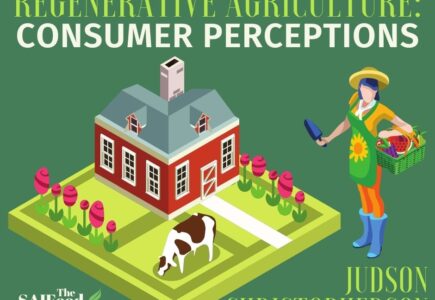Introduction
Arguably, the consumer perceptions facet of this blog series should have been the lead off, as it is consumer perceptions that drive product markets. This is true of agriculture as well, as consumers drive demand for goods and services, their willingness to pay (or lack thereof) determines the value of goods in the marketplace. Further, consumers are taxpayers and voters in many cases, indirectly dictating the policy frameworks governing agriculture. Every player in the supply chain, farmers, processors, food companies, and even policymakers, require consumer approval to function. Without this, they may operate but not for any substantial duration of time. As such, it is fitting that regenerative agriculture (RA) be analyzed though the consumer lens.
In the modern day, consumers are notably disconnected from production agriculture. Even in agriculturally driven nations like Canada, only 3% of Canadians had direct ties to a farm in 2017. With industry consolidation occurring in both grain and livestock production, this number continues to shrink every day. As a result, transparent and consistent communication between producers and consumers is paramount to ensure accurate information is shared. Regenerative agriculture, despite receiving much in the way of accolades from policymakers and major food companies, has underperformed in terms of consumer knowledge. This is a trend common to many facets of agriculture; however, if RA wants to truly differentiate itself from modern agriculture it should improve its communication to consumers.
Importance of Communication in Agriculture
Given the shockingly low percentage of Canadians that have direct ties to a farm, communicating what occurs on Canadian farms to the general public is of utmost importance. Informing the public on agriculture practices, explaining what producers are doing – and more importantly – why they are doing it expands the knowledge base of consumers. In turn, greater knowledge on a topic has been shown to enhance perceptions towards a topic whereas distrust may form if knowledge gaps are present.
Exacerbating the need for communication is the prospect of misleading narratives reaching consumers ahead of scientific merit. Within the current state of social media, misinformation and disinformation are prevalent across platforms, harbouring narratives that can damage consumer trust in agriculture. Often, these posts are unfounded, lacking scientific backing, and without resources to accompany the claims. However, with social media platforms designed to propel any information that garners reaction, these posts can quickly spread to a wide swath of consumers. Relative to the scientific process, misinformation can move at a rapid pace, providing consumers with biased and false information that may alter their buying habits.
Consumer Awareness and Understanding of Regenerative Agriculture
Despite the exponential trajectory of RA in academic, political, and agricultural realms, it appears consumers have not yet taken interest in the set of practices and principles underlying RA. A 2021 survey found that only 19% of Americans had heard of regenerative agriculture. Compare this to approximately 60% of people who had heard of both organic farming and crop rotation. Interestingly, 37% and 33% of respondents indicated they had heard of soil restoration and soil health, respectively. Concerningly, less than 20% of respondents had heard of no-till farming and nitrogen fixation, two mainstays of current agriculture sustainability efforts.
Opinion-based questions were also asked as part of the survey and it appears consumers may have some misperceptions that may benefit RA producers. Namely, 51% of people responded the presence of RA is very important when considering the overall healthfulness of the product. While this question is broad, one could interpret this result as consumers perceiving products grown with RA improves the nutritive value of human consumption. However, this could not be further from the truth. Nutritious foods such as whole grains, meat, and vegetables will not noticeably differentiate between RA and conventional systems. On the contrary, a potato chip will not be a healthy choice regardless of the manner in which the potato was grown.
Concluding Remarks
It appears the knowledge gap between the farm gate and consumers is growing as many urban consumers do not have a broad understanding of what goes into producing the food they eat. In an increasingly specialized consumption economy, this is expected, and consumers are not to blame. As agricultural producers, researchers, and advocates it is our task to ensure the public both understands and accepts the practices on our farm. Currently, a very small portion of consumers have heard of regenerative agriculture, surprising, given the attention it has received from multinational food companies. Nonetheless, educating consumers on the potential benefits of RA – as well as its numerous drawbacks – is critical to the success of agriculture. Providing information is not enough, consumers must be able to digest the information, and willing to seek out answers to any questions they may have. Broad scale adoption of RA practices is highly unlikely. However, if this is something a broad swath of consumers seek, the public and policy pressure on farmers could become overbearing. Ensuring consumer perceptions remain favourable to all swaths of agriculture through an understanding of different economic, environmental and productivity trade-offs at play is an important challenge. This is not a new problem, nor one that is easily solved however, it will define progress of production agriculture throughout the coming decades.

